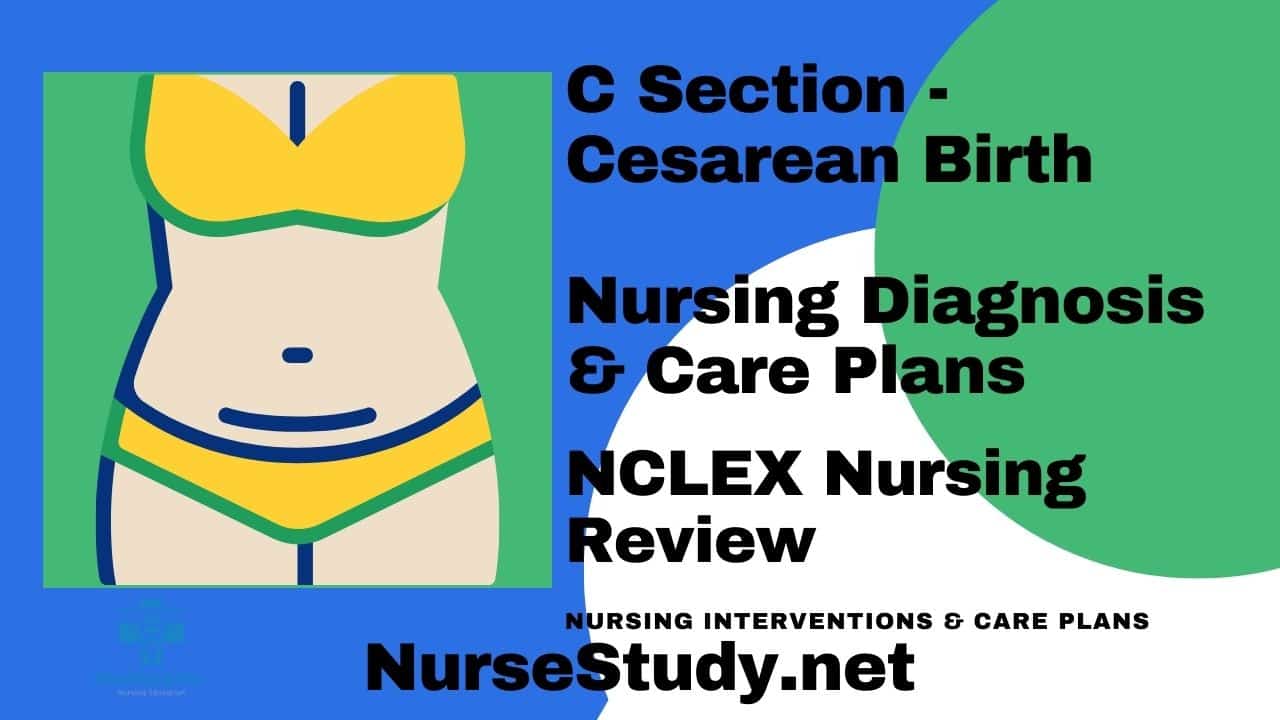A cesarean section (C-section) nursing diagnosis requires careful assessment and planning to ensure optimal patient outcomes.
C-section delivery is a major surgical procedure that requires specialized nursing care before, during, and after the operation.
Key Components of C-Section Nursing Care:
- Pre-operative assessment and preparation
- Post-operative monitoring
- Pain management
- Wound care
- Prevention of complications
- Patient Education
- Emotional support
- Recovery assistance
Nursing Assessment for C-Section Patients
Physical Assessment
Vital Signs Monitoring
- Blood pressure
- Heart rate
- Temperature
- Respiratory rate
- Oxygen saturation
Abdominal Assessment
- Incision site
- Fundal height
- Uterine tone
- Lochia characteristics
Pain Assessment
- Pain level
- Pain characteristics
- Response to pain management
Psychological Assessment
Emotional Status
- Anxiety levels
- Mood changes
- Signs of depression
Support System
- Family presence
- Available resources
- Home support
C-Section Nursing Care Plans
Nursing Care Plan 1. Acute Pain
Nursing Diagnosis Statement:
Acute pain related to surgical incision, tissue trauma, and uterine contractions as evidenced by verbal reports of pain, guarding behavior, and facial grimacing.
Related Factors/Causes:
- Surgical trauma
- Tissue manipulation
- Uterine involution
- Movement and position changes
Nursing Interventions and Rationales:
Assess pain characteristics regularly
- Helps determine the effectiveness of pain management
- Enables early intervention
Administer prescribed pain medications
- Provides adequate pain relief
- Prevents pain escalation
- Teach proper positioning techniques
- Reduces pressure on the incision
- Promotes comfort
Implement non-pharmacological pain management
- Complements medication therapy
- Provides additional comfort measures
Desired Outcomes:
- The patient reports decreased pain levels
- Demonstrates improved mobility
- Uses effective pain management strategies
Nursing Care Plan 2. Risk for Infection
Nursing Diagnosis Statement:
Risk for infection related to surgical procedure, surgical incision, and decreased immune function during the postpartum period.
Related Factors/Causes:
- Surgical wound
- Invasive procedures
- Compromised immune system
- Extended hospital stay
Nursing Interventions and Rationales:
Monitor incision site
- Early detection of infection signs
- Promotes timely intervention
Maintain strict aseptic technique
- Prevents cross-contamination
- Reduces infection risk
Educate about proper hygiene
- Promotes wound healing
- Prevents complications
Monitor vital signs
- Detects early infection signs
- Enables prompt treatment
Desired Outcomes:
- Wound healing without complications
- No signs of infection
- Demonstrates proper wound care technique
Nursing Care Plan 3. Impaired Physical Mobility
Nursing Diagnosis Statement:
Impaired physical mobility related to surgical pain, decreased muscle strength, and presence of medical devices as evidenced by difficulty turning, getting out of bed, and walking.
Related Factors/Causes:
- Post-surgical pain
- Presence of IV lines and catheters
- Fatigue
- Fear of movement
Nursing Interventions and Rationales:
Assist with early mobilization
- Prevents complications
- Promotes recovery
Teach proper body mechanics
- Reduces strain on incision
- Prevents injury
Provide assistive devices
- Promotes independence
- Ensures safety
Monitor activity tolerance
- Prevents overexertion
- Guides activity progression
Desired Outcomes:
- Demonstrates safe mobility techniques
- Increases activity gradually
- Maintains proper body alignment
Nursing Care Plan 4. Anxiety
Nursing Diagnosis Statement:
Anxiety related to surgical procedure, recovery process, and new parenting role as evidenced by expressed concerns, restlessness, and increased tension.
Related Factors/Causes:
- Surgical experience
- Recovery uncertainty
- New parent responsibilities
- Limited knowledge
Nursing Interventions and Rationales:
Provide emotional support
- Reduces anxiety
- Builds trust
Offer clear information
- Increases understanding
- Reduces fears
Encourage expression of concerns
- Allows emotional release
- Identifies specific fears
Teach coping strategies
- Provides tools for management
- Promotes self-control
Desired Outcomes:
- Expresses decreased anxiety
- Uses effective coping mechanisms
- Demonstrates understanding of the recovery process
Nursing Care Plan 5. Risk for Ineffective Breastfeeding
Nursing Diagnosis Statement:
Risk for ineffective breastfeeding related to surgical pain, positioning difficulties, and delayed milk production.
Related Factors/Causes:
- Post-surgical discomfort
- Positioning challenges
- Delayed lactation
- Limited mobility
Nursing Interventions and Rationales:
Assist with positioning
- Ensures comfort
- Promotes effective latch
Provide lactation education
- Increases knowledge
- Builds confidence
Monitor feeding patterns
- Ensures adequate intake
- Identifies problems early
Offer support resources
- Provides ongoing assistance
- Promotes success
Desired Outcomes:
- Demonstrates effective breastfeeding techniques
- Reports comfortable feeding sessions
- Shows signs of adequate milk transfer
References
- American College of Obstetricians and Gynecologists. (2023). Cesarean Birth. ACOG Practice Bulletin, 205, 25-37.
- Johnson, R., & Taylor, W. (2023). Skills for Midwifery Practice. Elsevier Health Sciences, 4th edition.
- World Health Organization. (2023). WHO recommendations for care following cesarean section. WHO Guidelines.
- Smith, J., & Jones, M. (2023). Evidence-based nursing care for C-section patients. Journal of Obstetric Nursing, 45(2), 112-124.
- Brown, K., & Wilson, D. (2023). Maternal-Child Nursing Care. Mosby, 6th edition.
- Davis, L., & Thompson, S. (2023). Post-operative care following cesarean delivery. American Journal of Nursing, 123(4), 45-52.
